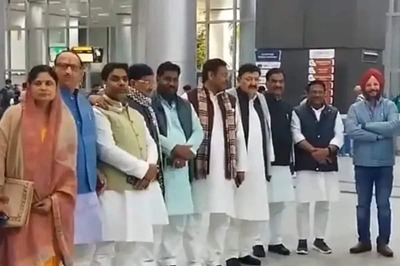
views
Prime Minister Narendra Modi recently announced that Chandrayaan-3’s landing spot near the Moon South Pole would be named as Shiv Shakti point.
The prime minister made the announcement while congratulating and interacting with scientists of the Indian Space Research Organisation (ISRO) headquarters in Bengaluru after the successful touchdown of the Vikram lander on August 23.
“There is a scientific tradition of naming the location of a touchdown. India has decided to name the lunar region where our Chandrayaan-3 landed. The place where Vikram lander descended will be known as Shiv Shakti point,” he said.
He also announced naming the point where Chandrayaan-2 left its imprints as Tiranga point and added that it will serve as an inspiration for every effort that India makes and remind us that failure is not the end.
But what are the rules regarding naming places on the Moon and does any country have jurisdiction over the lunar surface.
Law regarding Ownership, Naming Sites
The United Nations 1966 Outer Space Treaty, which came during the Covid War Era when the USSR and US were locked in competition, said that no nation can claim sovereignty over the moon – or other celestial bodies – and that the exploration of space should be carried out for the benefit of all countries.
The 1979 The Moon Agreement states that no part of the moon “shall become property of any State, international intergovernmental or non-governmental organization, national organization or non-governmental entity or of any natural person.”
Therefore, the law clearly states that nations cannot law claim to moon or its land, however they can carry out certain activities.
According to Alexander Soucek, head of public international law at the European Space Agency, “A nation can plant a flag on the moon, but it doesn’t have any legal meaning or consequence.”
However, there is no legislation regarding naming places on the Moon.
Who Can Name sites on Moon?
Naming spots and places on lunar surfaces started as early as the 17th century in Europe and in the 20th century the United States and the USSR when the nations sending lunar explorations started assigning names to the lunar spots.
The International Astronomical Union (IAU) determines some rules for Space activities. India is one of the 92 members of the space body.
“The IAU has been the arbiter of planetary and satellite nomenclature since its inception in 1919,” its website reads.
Many countries have been giving informal names to the spots on moon during lunar missions. The United States gave informal names to lunar sites during Apollo missions. China has also been naming geographical entities on the Moon since 2010.
However, with the advancement of technology and exploration of the darker side of the moon, more lunar sports like craters were assigned names of scientists and engineers. Later, these names were sent to the IAU for its approval, according to The Indian Express.
Most of the informal names assigned during Apollo mission were later given “official” status by the IAU. It also approved eight Chinese names for features around the area on the Moon explored during China’s spacecraft Chang’e-5.
“An informal practice of naming landmarks was common during the Apollo missions. Names were given to the small craters and mountains near each landing site (e.g., Shorty, St. George, Stone Mountain) but official names were used as well (e.g., Hadley Rille),” scientist Paul D Spudis wrote in the Smithsonian Magazine in 2012.
Process for considering names?
The IAU’s Working Groups handle the process of naming lunar spots, though its decisions and recommendations are not enforceable by any international law.
However, there are established conventions regarding astronomical objects and processes which are as follows:
- When the first images of the planet surface or satellite are obtained, then themes for naming features are chosen and names of important features are proposed by members of the appropriate IAU task group.
- After higher resolution images are available, the names for additional features may be requested by investigators mapping or describing specific surfaces or geological formations.
- Though anyone can suggest that a specific name, but there is no guarantee that the name will be approved. The names will be successfully reviewed by a task group are submitted by the task group chair to the Working Group for Planetary System Nomenclature (WGPSN).
- However, the lunar or planetary surface cannot have names of political, military or religious significance except for names of political figures prior to the 19th century.
- After successful review by vote of the WGPSN members, the names are considered officially approved and can be used on maps and in publications.




















Comments
0 comment